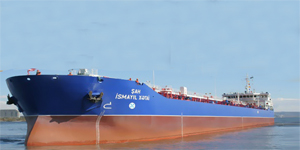Home page
» TRANSPORT
» Water transport
Water transport Water transport is the cheapest type of transport. Baku- the beginning point of all sea transport of Azerbaijan is the largest port in the Caspian. It is possible to swim from Baku to Astrakhan, Makhachkala, Central Asia, and to the Anzali port of Iran. Azerbaijan has access to the world ocean via Caspian → Volga river → Volga — the Don channel → Don river → Azov sea. Besides the Volga-Don channel, Azerbaijan ships have direct access to the world ocean via Volga-Baltic and Baltic-White sea channels. Baku-Turkmenbashy, Baku-Aktau and Baku-Bekdas railway ferry crossing connects two coasts in 11 hours. Azerbaijan State Caspian Shipping and Baku Trade Seaport plays a significant role in the water transport of Azerbaijan. Azerbaijan State Caspian Shipping The transport fleet consists of 71 transport ships, and one water-carrying vessel. 36 of them are liquid cargo ships- tankers, 7 are ferry-vessels, 2 are universal vessels of RO-RO type, and 26 are dry cargo ships and the total deadweight is 375 000 tons. In the transport fleet 23 dry cargo vessels make commercial voyages in the Black and Mediterranian basins on the basis of time-charter agreement, the rest of the vessels are used in the Caspian basin. In the Caspian sea shipping plays the role of connector in the Europe-Caucasus-Asia (TRACECA) transport corridor. Railway carriages, trucks and passenger ferry-vessels and tankers are used currently for the transporttion of cargo in the Transcaspian direction. The tanker fleet of the Caspian Shipping is the most powerful one in the Caspian. The Euroasian corridor extends from the Lyanyunqan port of China till Vienna, Austria. This is approximately 11-12 000 kilometres. The cargo is carried with different types of transport vehicles through a number of countries that have various legislations, customs and border procedures. The Euroasian corridor is the main cargo base in the Caspian sea for the Caspian Shipping. The transportation is carried out with the tankers of the Caspian Shipping in the Aktau-Absheron, Alaca-Absheron, Alaca-Baku, Okarem-Absheron, Okarem-Baku and Turkmenbashy-Baku routes Baku Trade Seaport The port consists of 5 terminals: 1. The main cargo terminal; 2. The container terminal; 3. The ferry terminal; 4. Dubendi oil terminal; 5. Passenger terminal. The main cargo terminal consists of 7 bridges the total length of which id 858 meters. One of this bridges is especially intended for the access of “RO-RO” vessels. Water depth in the bridges is equal to 7 meters. Technical base consists of 16 portal cranes with 5-40 tons of load capacity, various types of auto-loaders with 1.5-10 tons of load capacity, 100 rolltrailers and pulling tractors of “Sisu” brand. Mainly piece-unit, pile and scattered wood, autotechnical and container cargoes are unloaded in the terminal.The terminal has the capacity of unloading 2 million tons of freight. Throughout the day, 3 vessels, up to 150 carriages, and 100 motor vehicles can be simultaneously received and unloaded. Total lenght of the terminal’s railways is 8 kilometers. The terminal posseses 4 diesel locomotives, locomotive brigade, depot, railway and truck scales for maneuvering. The terminal has an open storage of 24 000 square meters and 5 closed storages the total area of which is 10 000 square meters. The container terminal has the capacity of receiving 15 000 containers per year. The terminal has a closed storage of 1250 square meters and container ground of 1600 square meters for working over the containers and the cargo inside them. In order to monitor the container operations, a speecially programmed computer system has been installed in the delivery point. All operations in the terminal are carried out with the help of 2 modern “Kalmar” container auto-loader, 2 “Terberg” tractors, 6 container trailers, and 3 “Hayster” auto-loaders each of which has the load capacity of 2.5 tons The oil terminal has 4 bridges the total lenght of 582 meters. 2 of them are in operation. The terminal may be used simultaneously for 4 tankers of 5 000-12 000 tons. The depth of water near the baridges is 9.6 meters. The oil terminal has the capacity of unloading 10 million tons of cargo per year. Vessel Traffic Management Service is in the terminal. Two towing vessels of 600 and 1600 weight capacity ensure safe approach of the vessels to the coast. The passenger terminal has a bridge of 130 meters. In the terminal, tour vessels serve to the residents and guests of Baku. Workers of the State Oil Company go to the Caspian oil fields from the passenger terminal. There is a Marine Fleet in Baku Seaport as well. The fleet has 20 vessels including towing vessels, vessels collecting oil wastes, fire-boats, losman boats, vessels for collecting slops and dirty waters, raid boats, crane vessels, tour vessels, fuel vessels. Baku Marine Station The station building was founded in 1970. The newly repaired station has ferry-boats going to Kazakhstan, Turkmenistan and Russia, two vessels have voyages to the Oil Rocks. There are banquet halls for 120 people, conference halls for 400 people, guestrooms and other service facilities.
|
